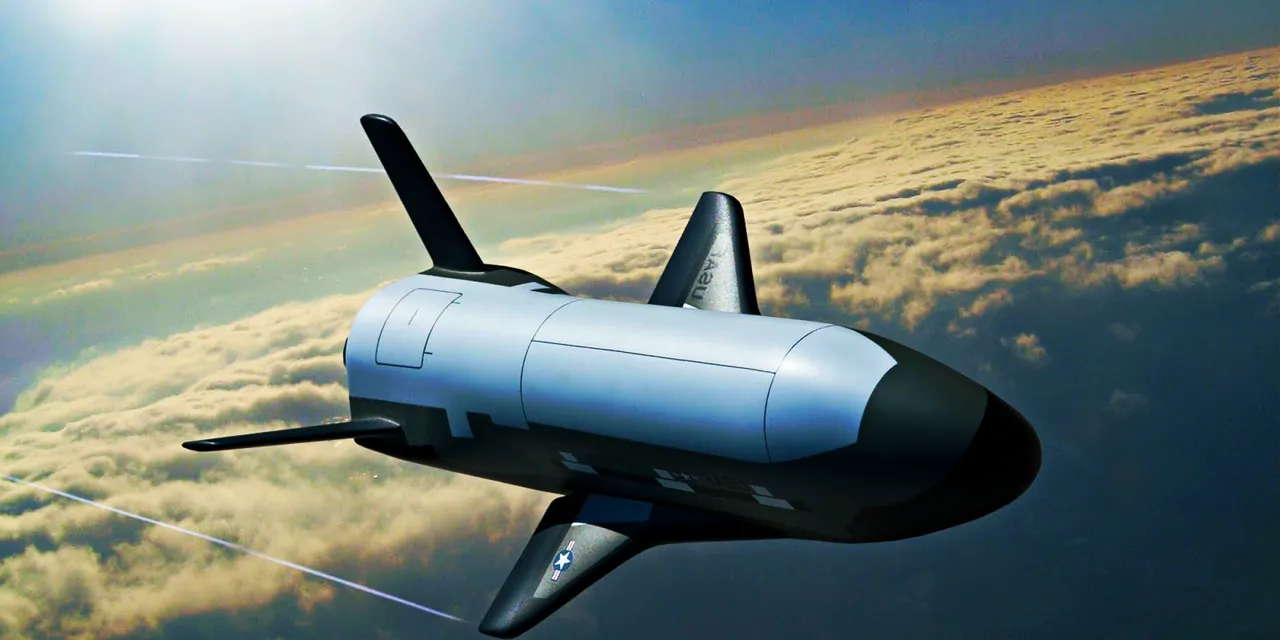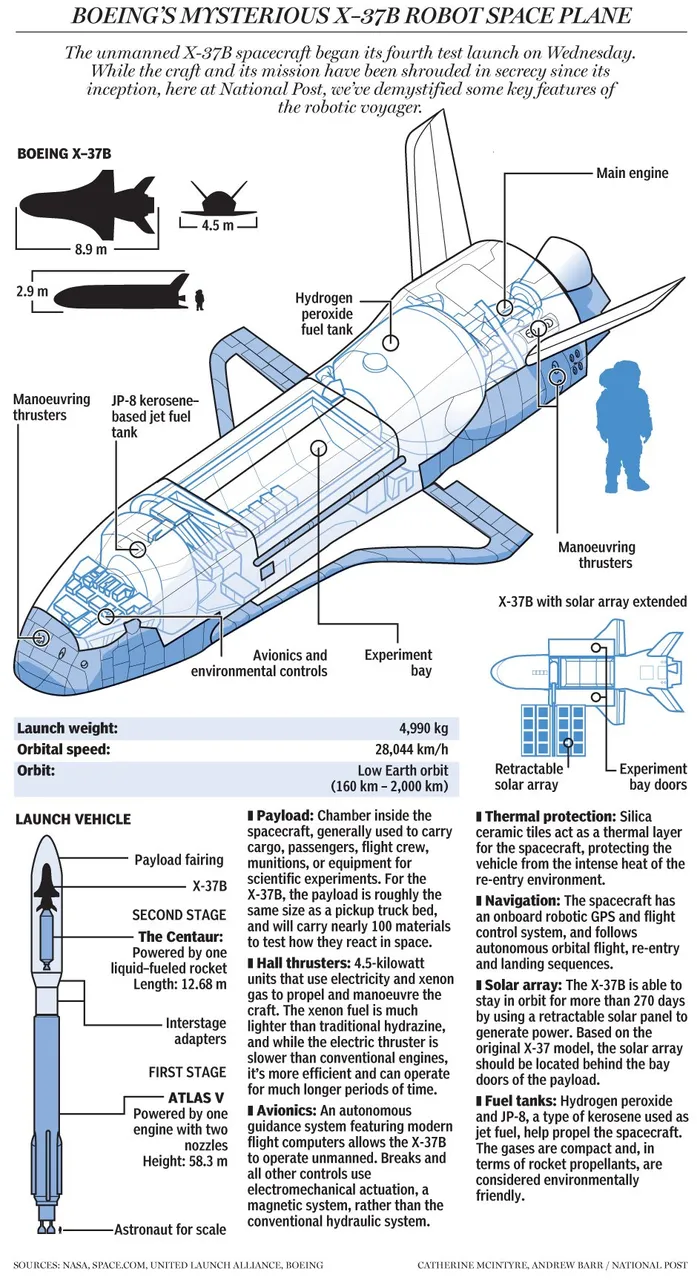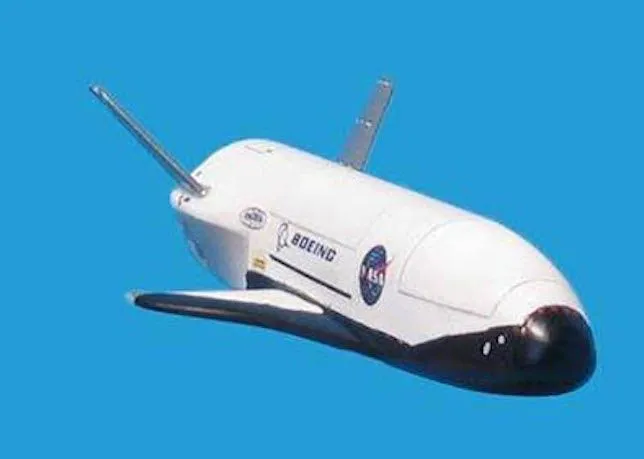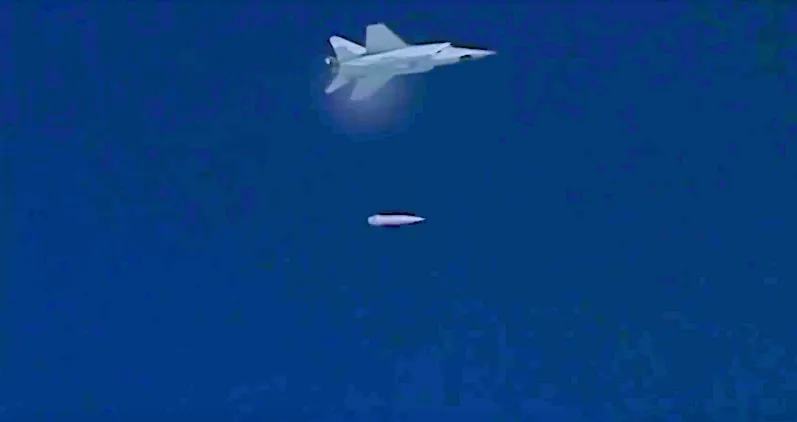
Introduction
https://wikileaks.org/hackingteam/emails/emailid/129018
The email being shared between members of the Hacking Team contains the work of
Subrata Ghoshroy who's research article The X-37B: Backdoor weaponization of space? was first published in the Bulletin of of Atomic Sciences on May 1st, 2015 (Vol 71, Issue 3, pp. 19 - 29).
http://bos.sagepub.com/content/early/2015/04/08/0096340215581360.full
The X-37B
On October 17th, 2014, a mysterious craft touched down at Vandenberg Airforce Base in Southern California capping off an extended secret mission that lasted almost two full years.
Launched in December of 2012 attached to an Atlas 5 rocket from Cape Canaveral, the X-37B unmanned space vehicle was originally scheduled to spend 270 days in low-Earth orbit conducting unspecified space related research.
Very little is known about the X-37B’s recent mission or any activities it engaged in, however the remotely controlled spacecraft spent 674 days in orbit, 300 days longer than scheduled.
The US Air Force (USAF) has provided information pertaining to the types of technologies involved in testing. These technologies include:
advanced guidance, navigation, and control; thermal protection systems; high temperature structures and seals; lightweight electromechanical flight systems; and autonomous orbital flight, reentry, and landing.
https://wikileaks.org/hackingteam/emails/emailid/129018
Initially, the X-37B was part of a joint program between NASA and the Department of Defense known as the X-37 project. This project also produced the X-37C, a transport vehicle capable of transporting astronauts and cargo to low-Earth orbit.
The main objective of the X-37B project was to develop reusable launch systems for space missions. Reusable craft have numerous advantages in that they significantly reduce cost while they also increase the reliability and speed of missions.
As we can see from this diagram, the X-37B craft is considerably smaller than the space shuttles NASA had in service for decades.

Although it is launched vertically from a launchpad, when this remotely operated vehicle returns to the ground it lands horizontally on an airstrip, like an airplane. Therefore, the vehicle can be thought of as a hybrid of spacecraft and aircraft. It can withstand the vacuum of space and maneuver there, yet it has wings that give the X-37B aerodynamic lift once it reenters the Earth’s atmosphere—allowing it to descend and land, gliding back home just like the space shuttle. The wings also help it to brake.

Ever since the X-37B touched down at Vandenberg air force base back in 2014, there’s been mounting speculation that the program’s true nature is to provide a stage to test space weapons technologies.
Through the X-37B program, the Air Force is gathering data on the travel of objects at extremely high speeds and developing cutting-edge space technologies that allow those objects to navigate and be controlled remotely over long distances. It is able to field-test on the very edge of space the latest thermal protection systems, high-temperature structures and seals, and lightweight electromechanical flight systems, which are part of what allows the craft to glide stealth-like to the ground. All of these features are vital for engaging what the military calls “time sensitive” targets in “anti-access/area-denial” environments—or, in plain English, for using high-speed missiles in counter-terrorism operations or for overcoming antimissiles. At such speeds, an enemy may barely have the time to detect an incoming missile on a radar screen before being destroyed.
https://wikileaks.org/hackingteam/emails/emailid/129018
Due to funding shortages, NASA was forced to remove itself from the X-37 project and eventually the research became a black project under the name X-37B as it was first relocated to the Defense Advanced Research Projects Agency (DARPA) and eventually being integrated into the Air Force’s Rapid Capabilities Office.
While private companies such as Space-X have made noticeable improvements towards achieving the goal of reusable rockets and spacecraft, there still remain definite hurdles. However, recent successful launches and landings by its Falcon rockets suggest that Space-X may be on the verge of accomplishing their goal of creating a reliable reusable rocket.

Hypersonic Propulsion
Another serious hurdle in producing viable reusable spacecraft is that these vehicles must be able to fly at “high hypersonic” speeds. Meaning, a craft must be devised that can handle re-entry speeds of about 17,500 mph / 28,164 km/h aka Mach 25. This is a formidable challenge since the world’s fastest fighter jets, such as the Russian MiG-31, are only able to reach “super sonic” speeds of Mach 2. In order to withstand the extreme heat and frictions experienced in reentry of the Earth’s atmosphere, prospective spacecraft require protective layers of specialty metals and alloys.
Knowledge gained from the experimental mission of the X-37B regarding hypersonic speeds, extreme temperatures and reentry technologies for peaceful space uses can easily be applied to more ominous programs such as the development of hypersonic missiles.
The USAF has been forthcoming in their interest in developing hypersonic capabilities with the Under Secretary of the Air Force Eric Fanning stating in 2015 that the USAF has spent over $100 billion in over the last 16 years towards “cutting-edge space technologies”.
High on the list of leading-edge or “game changing technologies” are hypersonic capabilities. David E. Walker of the US House Armed Services Committee is reported to have elaborated on the US governments desire to develop such capabilities.
Walker said that getting objects to travel at super-high speed provides options for engaging “time sensitive” targets in “anti-access/area-denial” environments.
…
Walker also said that the Air Force is interested in developing a hypersonic cruise missile called the High Speed Strike Weapon (HSSW). For it to mature, several crucial technologies must be developed. Among them are materials that can withstand high temperatures; guidance, navigation, and control systems that work at hypersonic speeds; and thermal protection and heat management—the very same technologies being developed under the guise of the X-37B.
https://wikileaks.org/hackingteam/emails/emailid/129018
Certainly, there are numerous tactical advantages for developing hypersonic weapons, particularly missiles. Chief among them is the ability to surprise an enemy by launching projectiles at extreme velocities capable of covering long distances and of reaching their targets in a short period of time.
Bombs dropped form aircraft typically reach speeds of 700 to 800 mph / 1200 to 1300 km/h but with boost-glide systems (eg. A rocket traveling at Mach 5 mounted with a projectile) could launch their payload gliding over long distances and reentering the atmosphere at hypersonic speeds. Enemy targets will likely be caught completely off guard, have almost no chance establishing radar contact or to deploy any missile defense systems.
As the title of Subrata Ghoshroy’s research article The X-37B: Backdoor weaponization of space? found in the Wikileaks archives suggests, experiments involving the X-37B could be a precursor to a modern day Star Wars program.
Hypersonic Weapons
In March 2018, the Telegraph reported on the unveiling of advanced weapons systems by Russian president Vladimir Putin. In particular, the article states that the Russian military has developed the world’s first known hypersonic missile, the “Kinzhal” or Dagger.
The missile appears to be a heavily modified version of Russia's Iskander short-range ballistic missiles, which are nuclear-capable. It is launched from the air by a MiG-31 fighter jet.
…
When the weapon is dropped from the plane, it is already in thin air and traveling at high speeds. After separating from the plane, Kinzha's engine ignites to propel it to 10 times the speed of sound.


The above images are taken from footage released by the Russian Defense Ministry that apparently showcase the use of boost-glide weapons. Already flying at supersonic speeds, the MiG-31 launches the Kinzhal in mid-flight. It's estimated that the Kinzhal has a range of 2000 km has been given the nickname the "aircraft carrier killer".
The Telegraph article describes how the US, China and Russia were all racing to develop hypersonic weapons technology but the Russians surprised everyone releasing footage of the a successful test launch of the Kinzhal missile.
Along with the disclosure of the Kinzhal missile, other hypersonic and also a new class of nuclear weapons have also been revealed by Russia. President Putin has stated that the development of next generation missiles comes as a response to the US having dropped out of the Anit-Ballistic Missile treaty (ABM) in 2002. At the time, both Russian and China were highly critical of Washington's move towards a renewed arms race.
On top of the boost-glide weaponry, Russia also revealed that the Russian Navy is developing the Zircon, another near-hypersonic missile that is said to be extremely agile, able to reach Mach 5 and scheduled for incorporation by 2020. The Zircon uses what is known as a “scramjet” (air-breathing) engine capable of performing at extreme velocities.
DARPA Weapons Develpment
Not to be outdone, the American military has also been actively developing their own hypersonic weapons. DARPA's X-51 A Waverider is an experimental scramjet based missile said to have reached near hypersonic speeds of about Mach 5. At these fantastic speeds the Waverider would be able to arrive at any target worldwide within an hour.
Valuable flight data and insight gained from the X-37B’s secret missions inevitably feeds into other government programs. Something else that DARPA has been actively pursuing state of the art satellite technology for geostationary space.
Meanwhile, DARPA is moving on to the next stage: exploring technologies for autonomous operations in geostationary orbit 22,500 miles above the Earth, where most communication satellites reside. In a formal Request for Information released on September 3, 2014, DARPA sought industry aid and advice on developing a “robotic servicer” designed for operating at that altitude. DARPA envisions a servicer that could inspect satellites, carry out repair missions, or assist satellites in orbit-change maneuvers (DARPA, 2014).
While benign-sounding on the surface, a robotic servicer that can carry out repairs or assist satellites could easily threaten the geostationary satellites of other nations. (A geostationary satellite moves in the same direction as the Earth at exactly the same speed, thus making it able to hover over a given spot on the ground indefinitely). Such operations would be particularly dangerous, because even an accidental collision could cause a shower of debris that endangers everything else at that altitude—and would effectively last forever.
https://wikileaks.org/hackingteam/emails/emailid/129018
In the same vein, the Chinese have also been testing anti-satellite technologies and have conducted tests with so-called "satellite catchers" in 2007 and 2013. The Chinese insist that the satellite technology that their testing is designed to remove space debris from Earth's orbit. Space debris also reaches hypersonic speeds while orbiting the earth and could annihilate spacecraft or satellites in a collision. Despite China's assurances many believe that the satellite catchers explanation is a yet another example of covert space weaponization.
A New Arms Race in Space
It's not difficult to see that a new arms race is well underway. This new arms race extends beyond our planets atmosphere involving next generation spacecraft and hypersonic weapons reminiscent of the Regan area Star Wars program.. It's entirely possible that space has already been secretly weaponized, if not, it certainly appears that the world is once again speeding towards this nightmarish future.
Nevertheless, there's still hope that the weaponization of space can be prevented. The UN has developed a proposal called PAROS (Prevention of an Arms Race in Outer Space):
Under the draft of the PAROS treaty submitted to the United Nations, participating countries would pledge to refrain from placing objects carrying any type of weapon into orbit, from installing weapons on celestial bodies, and from threatening to use force against objects in outer space. They would also agree to practice measures to build confidence in commitments to refrain from weaponizing space.
https://wikileaks.org/hackingteam/emails/emailid/129018
The United States has shown little interest towards any binding international agreements on a ban of weapons in space, perhaps believing that the US will continue to enjoy technological supremacy in a new arms race. This may indeed be the case, but as we've seen the Russians have surprised the world by divulging information on their advanced hypersonic missile programs.
The dangers posed by space weaponization and warfare are numerous. There are no winners in this high stakes arms race, everyone loses. But perhaps the country that stands to lose the most is the United States which possesses almost half of all the satellites in orbit, 512 total. With command of 159 military satellites, the United States has more than the total number of Russian satellites with 135 and 116 of the Chinese variety.
Even a minor space battle could result in the near-Earth heavens being littered with debris, rendering them uninhabitable for all satellites.
https://wikileaks.org/hackingteam/emails/emailid/129018
Additional Sources
https://wikileaks.org/gifiles/docs/16/1645957_re-ct-us-secret-nro-spy-satellite-launches-into-orbit-.html
https://wikileaks.org/gifiles/docs/80/804666_chn-china-asia-pacific-.html
https://wikileaks.org/gifiles/docs/19/198770_-os-us-space-mil-tech-usaf-extends-x-37b-space-plane-s.html
https://en.wikipedia.org/wiki/Scramjet
http://atomicarchive.com/History/coldwar/page20.shtml
http://www.thesleuthjournal.com/china-launches-technology-capable-destroying-us-military-satellites-video/

Note: I'm not in contention for any of the prizes from the challenge, this entry is just my contribution this week towards building a body of research on the blockchain.

